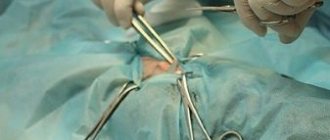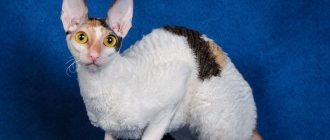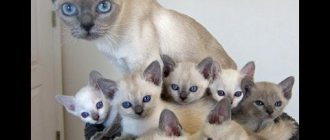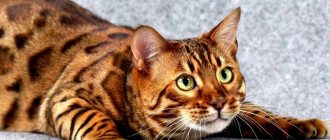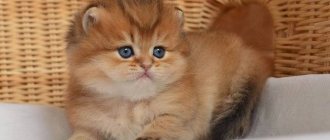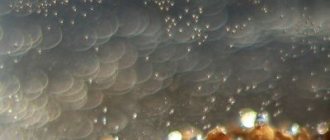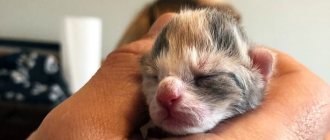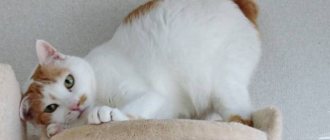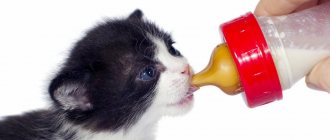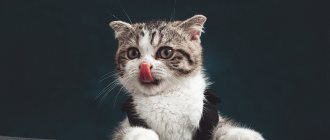How and what to feed Persian cats correctly? These beauties are the most beautiful of the domestic cat family. These are magnificent animals with an absolutely individual, memorable and easily recognizable appearance. The most successful attempt by a person to create an “eternal kitten” with a sweet short face and an unusually easy-going disposition. The Persian lifestyle is leisurely and measured. These cats sleep 18-20 hours a day. And it seems that they - melancholic by nature - are not interested in anything in the world! But this is far from true. In fact, they are closely observing everything that is happening through the barely opened eyelids of bottomless round Persian eyes.
Nutritional features of Persian cats
Persian cats should be given a balanced diet. Their daily menu should include foods rich in proteins, vitamins, fats and carbohydrates.
As you know, proteins in the animal’s body are broken down into amino acids. The latter, in turn, are extremely necessary in the construction of biological tissues, for example, bone and muscle, skin and claw plates. Therefore, protein products are indispensable in the diet of a Persian cat.
With an insufficient amount of arginine (it is not synthesized by the Persian body), serious problems begin with energy metabolism, metabolism, brain function and the gastrointestinal tract.
Taurine is also considered a necessary component for the cat's body. It helps maintain good functioning of the cardiovascular system, and also prevents eye diseases, to which Persians are so prone.
Carotene cannot be produced by the Persian cat's body, so the animal can only obtain this component necessary for health with vitamin complexes or industrial food.
Do not forget that Persians are prone to urolithiasis. Excessive amounts of mineral salts contribute to the appearance of conglomerates, so it is recommended to limit foods such as milk and fish in the diet of this breed.
In addition, the pet owner should follow the following rules:
- It is strictly forbidden to mix wet and dry ready-made food. The interval between meals of these two types of food should be at least 10-12 hours. If you do not heed this advice, your Persian may experience digestive disorders. Moreover, “individual” nutrition increases the load on the Persian’s liver.
- You should also not mix food from different manufacturers, for example, mousses and pates, or diets that take into account age and individual characteristics - dry food for kittens and sterilized cats, etc.
- There should be an interval between meals of homemade food and finished industrial products. It is worth waiting until it is completely digested.
- The share of wet food in the total volume of food for Persian cats should not exceed more than 25%.
Diseases and their prevention
Let's look at common diseases of Persian cats.
Persians often suffer from diseases such as polycystic kidney disease, hypertrophic cardiomyopathy, hip dysplasia, and skin cancer. Due to the specific structure of the muzzle, the eyes may suffer from retinal atrophy.
Normally, Persians often have watery eyes, but if the discharge is white and opaque, it could be a symptom of the flu. If your eyes are pusy, the cause may be an infection. Excessive tearing is often caused by allergies.
If a cat's eyes water profusely and a brown and black mass comes out of them, these are symptoms of an inflammatory process.
All these diseases must be treated by a specialist.
Diet
Just like other pets, Persian cats should eat at approximately the same times. Although Persians are very gentle and vulnerable animals, they need to be taught discipline. The cat should have a single place for eating; it should not be taught to take tasty things from the hands of the owner.
The number and volume of servings directly depends on the age of the cat:
- up to one month – feeds on mother’s milk as needed;
- 1-2 months – up to 6 times a day;
- 2-4 months – the number of meals is reduced to 4-5 times;
- 4-6 months – the animal is transferred to three meals a day;
- from 10 months – can be switched to adult cat mode – 2 times a day.
The daily intake for a Persian baby is calculated according to the formula: 250 g per 1 kg of live weight. For an adult, this norm can increase by 100 g.
Conditions of detention
These cats feel great when kept indoors and do not want to go outside. Moreover, due to weak immunity, walks are undesirable for them.
They are very attached to their owner and strive to spend as much time as possible with him. They react sensitively to moods and try to console and protect as best they can. They are calm and patient, do not get out of control, and usually easily tolerate children's games.
Cats caring for small kittens need special attention, as they may be torn between their desire to spend time with their owner and their maternal instincts.
It is advisable to purchase a house for your pet - it is important for cats to have a personal protected space. Please note that under no circumstances should you take your pet out of the house - only call or lure it in, without using force.
It is advisable to purchase a ceramic bowl. Glass and aluminum are less recommended. Plastic is harmful - it accumulates dirt and promotes the growth of bacteria. The cat's bowl should be washed after every meal, especially when using natural and commercial wet food.
New owners usually have a question about what to call a Persian cat.
The nickname should reflect the nobility of the breed, but at the same time be easy to pronounce and be harmonious. When deciding what to name your cat, pay attention to its appearance or habits.
The boy's kitten can be called Amber, Tiger, Sultan, Renoir. Suitable names for a girl are Perseus, Tutti, Iriska. You can also call the cat Vivien, Amanda, Louise.
Natural food for a small Persian
In fact, up to two months of its life, the little press feeds exclusively on mother's milk. Then they gradually begin to introduce him to adult food, but there is no need to rush into this, because the baby’s gastrointestinal system is very delicate. Experts call the best period for the first complementary feeding 5-6 weeks of life.
To begin with, you can introduce the kitten to porridge. It should be boiled in milk diluted with water. In order for the baby to easily “cope” with such food, the porridge needs to be not hot (up to 37℃) and very liquid. Of course, you shouldn’t add salt or sweeten the dish.
At about the age of 3 months, it is recommended to start giving your baby frozen meat. Naturally, you first need to defrost it, pour boiling water over it and chop it as much as possible with a knife. A single dose of this product for a baby up to 4 months is 0.5 teaspoon. Vegetables should be introduced last, since the Persian kitten’s body does not immediately accept them well.
Starting from 5 months, you can introduce foods such as cottage cheese, yogurt, and quail eggs into the diet. It is also allowed to give pets a variety of meat, cereal, vegetable, and cottage cheese mixtures intended for children.
Dry food begins at six months. Until the kitten learns to chew it normally, it is recommended to pre-soak the granules in warm water or meat broth. Special premium wet food for kittens is also allowed from 4-6 weeks of age.
History of the breed
Unfortunately, there is no clear opinion about the origin of Persian cats. Among scientists studying these long-haired animals, there are two opinions about this. Let's look at each of them in detail.
According to the first theory, the Persian was brought to Europe around 1620-1630 by an aristocrat from Italy named Pietro della Vallee. He discovered this breed while traveling in Turkey and Persia and decided to acquire beautiful representatives of this species. He acquired several animals, took them to Italy and described the cats in a letter to the French scientist Nicole-Claude Farby, who was an avid cat lover. He was very interested in previously unseen animals and he brought them to France. The European aristocracy was delighted with long-haired luxury cats. Even the great Cardinal Richelieu could not contain his delight. The breed caused a boom among the nobility and quickly moved into the category of the most elite. The Persians became a symbol of wealth, luxury and prestige.
The second theory says that the spread of the breed began in Russia. Scientists claim that the thick coat of wool was natural for the frosty northern parts of the country, and they came to the eastern countries precisely from Russia, from where they were exported to Europe in the 17th century.
When the Persians came to England, British felinologists divided them into two breeds. The cats really looked different. Some had thin and soft fur, as well as an elegant body. And others had a massive round head, short stature, long hair and a thick undercoat. So, the British classified the first representatives of the breed as Turkish Angora cats, and the second were first called French, and then Persian. In 1887, the breed was registered under the name “Persian Longhair”.
Further development of the breed took place in the United States, where cats were brought at the end of the 19th century. Breeders worked to create a unique breed based on the Persian and got excellent results. In appearance, the animals began to differ from representatives of the classical breed: a shortened nose, an overhanging forehead, characteristic folds from the inner corners of the eyes to the corners of the lips, the distance of the eyes from each other, etc. But along with their unusual appearance, they also acquired health problems, so the breeders became more active and again coped with the task. The result was an “extreme” type of Persian cat, the popularity of which grew every day. Photos of the animals quickly spread and the popularity of the breed instantly jumped.
What to feed an adult Persian cat
Just like most other cats, Persians need to eat meat frequently. In their daily diet, the meat part should be at least 50-60%. The share of vegetables in the total volume should not be more than 30%, and cereals - more than 10-18%. The following group of products is included in the daily menu for natural feeding:
- Meat . The most beneficial benefits come from lean boiled or chopped raw meat - chicken (dietary low-fat parts, for example, brisket), rabbit, beef, veal, lamb.
- Offal . Pieces of raw cow stomach will be the most useful. Persians also love chicken kidneys and hearts. You should avoid chicken necks or bone sets.
- Fish . This product is not paramount for the Persian breed. You can feed your four-legged friend fish no more than once every two weeks. It is better to give preference to marine and low-fat varieties. It is generally better to avoid river fish.
- Dairy and fermented milk products . Persians consume kefir with great pleasure. The optimal percentage of fat content is 1%. You can also give cottage cheese; if desired, your pet can dilute it with a small amount of water or yogurt. Low-fat yogurt can also be given. But it’s better to avoid cow’s milk altogether. In Persian cats it often causes diarrhea and bloating.
- Vegetables . It is recommended to add zucchini, cauliflower, carrots, pumpkin, green beans, and beets to meat dishes.
- Eggs . Not all cats, including Persians, can cope with digesting chicken eggs. However, they are a source of protein necessary for the body. Therefore, quail eggs would be the best option. They can be given to cats both raw and boiled.
- Cereals. The most suitable from this group are rice, barley and buckwheat.
It is recommended to approach the choice of each product as responsibly as possible. Persians should only eat freshly prepared food. Given their sensitive digestive system, you should not leave “for tomorrow” what was not eaten on time.
How to care
Caring for Persians must be thorough: they are very dependent on humans and are practically unable to take care of themselves.
Wool
The luxurious fur of the Persian cat should be combed every 2-3 days. This is done in three stages: first, superficial combing with a rare comb, then the main one with a medium comb, and finally, smoothing. At the end, you can use a spray and a special antistatic agent.
Persians need to be bathed once every 2-3 months with a specialized shampoo.
In summer, these cats are recommended to have their hair cut to avoid overheating. It is also useful during shedding, since trimming a Persian is easier than cleaning his hair every day. There are many original options for cutting Persian cats.
Eyes
Beginning owners are usually concerned with the question of why Persian cats often have watery eyes. In fact, this is due to the specific structure of the muzzle and with moderate colorless discharge is considered the norm.
Eyes should be wiped daily with a cotton pad soaked in tea, boric acid or boiled water. If the animal has light fur (for example, peach-colored), it is better not to use tea - it can color it.
If the tearing becomes particularly severe or brown discharge appears from the eyes, the animal should be taken to the veterinarian.
Ears
The auricle of these cats is very sensitive to mechanical damage, and it must be examined with extreme caution. If the ears are dirty or have excess wax, clean them with a cotton swab. If there is a dark crust in the ear, you need to show the animal to a veterinarian - most likely, treatment for parasites will be required.
Claws
There must be a scratching post in the house. In addition, the claws should be trimmed regularly: on the front paws once every 2 weeks, on the hind paws - once a month.
Recipes for Persians
Persians love homemade cutlets. Of course, both in their composition and in the method of preparation, they differ significantly from those that people eat. The basis of the cat treat is dietary meat. It needs to be cut into pieces and boiled in clean water for approximately 10-17 minutes.
Separately, you need to boil any of the cereals (about 10-15 minutes). Both products must cool, and then it is recommended to mix them and form cutlets. The prepared semi-finished product must be stored in the refrigerator for 3 days. Before “serving” the cutlets need to be warmed up a little. The temperature of prepared dishes should not be more than 40℃.
You can also prepare your own wet food based on the type of production diet. To do this, you need to take 50% meat, 30% permitted vegetables and 20% cereals. Meat and cereal should be pre-cooked over a fire for 15-20 minutes. Vegetables can be added raw. Combine all components and mix. For greater benefit, you can add a small amount of olive or corn oil to this dish.
Arguments against"
At the very beginning, you need to understand the difference in the diets of adults and recently born pets. The former eat less often, but in large portions, while the latter, on the contrary, eat every couple of hours, but little by little. But you shouldn’t make hasty conclusions that you can fill a bowl with food (the same thing that you feed large animals), put it under the kitten’s nose and wait for it to grow into a healthy and beautiful cat.
During the period of active growth, pets need high-calorie food, otherwise there will not be enough energy for either play or full development. Formed individuals do not need so many calories, so cat food has a relatively low nutritional value. Feeding your baby such food is fraught with delays in development and growth.
In addition, small animals need a large amount of macro- and microelements, as well as vitamins. Their deficiency provokes inhibition of development. The composition of cat food cannot boast of the required concentration.
In addition, the feeds also differ in the size of the granules. Adult felines can easily chew and swallow large pieces, but kittens simply run the risk of choking.
The best ready-made (industrial) rations
Ready-made industrial feeds from leading manufacturers help satisfy all the gastronomic needs of the Persians, as well as provide their bodies with useful microelements and vitamins. After analyzing the products available on the market, experienced veterinarians and breeders have compiled a list of the best foods for the Persian cat breed:
- Golden Eagle Holistic Adult Cat . Natural food from an American manufacturer. It contains approximately 32% of the protein Persians need. This product was a joint development of nutritionists, geneticists and veterinarians. Can be used by cats during pregnancy and feeding.
- Orijen Cat 6 Fresh Fish . Canadian granular product, characterized by a strong and pleasant smell for the animal. It contains different types of fish and a vitamin complex.
- Royal Canin Persian . A very appetizing French product created specifically for the Persian breed. It contains chicken meat, vegetables and grains. Prevents diseases of the digestive tract and ensures the beauty of the coat.
- Purina Pro Plan Delicate . Developed by Italian specialists specifically for those cats that have problems with the digestive system. More than 40% of the feed is protein. Also contains a vitamin complex.
- Bosch Sanabelle Hair. Offer from a manufacturer from Germany. The formula of this ready-made dish is designed specifically for long-haired cats. It has a positive effect on the digestive system and is made from poultry meat, rice and vegetables.
The ideal, according to many experts, would be industrial feed consisting of:
- pure meat – by 30-35%;
- plant fibers – up to 20%;
- protein natural filler – approximately 20%;
- offal or bone meal – up to 10%;
- natural oils;
- vitamin and mineral complexes.
If the owner decides to feed the cat commercial food (especially dry food), it is recommended to ensure that he drinks plenty of clean water.
Which food to choose
Today, pet stores offer a large selection of food for kittens - from budget to super premium. How are they different?
Economy
Produced from cheap raw materials. The composition, as a rule, includes meat by-products, soy, as well as preservatives, dyes and various flavor enhancers. That is why it is extremely undesirable to constantly feed your pets such food, despite the fact that they gobble it up with great pleasure. The vitamin content is minimal, so you will have to additionally give various vitamin and mineral complexes.
Cheap food contains addictive substances. As a result, the animal, like a dependent person, refuses to consume a quality product and experiences some kind of withdrawal.
Premium
The cost of such cat food is slightly higher, which is due to the inclusion of natural meat. But despite this, the components include by-products, vegetable protein, and preservatives with dyes. A certain proportion of useful substances is present, but periodically it is still worth adding vitamins and minerals to your pet’s diet.
Superpremium
Only meat is used for production. The product is perfectly balanced, it contains everything that a growing body needs. There are no flavor enhancers or flavorings in it, the only preservative is vitamin E, which brings nothing but benefits. Due to high demand and high cost, you can often come across a fake, so buy only from trusted places.
- What to feed Persian kittens, cats and cats
- What to feed kittens at home?
- How to feed a newborn kitten without a cat?
Combing wool
Many experts believe that you need to comb your cat with a so-called slicker brush, but this is one of the most common mistakes. Slickers can be used only in exceptional cases, and it is better not to use such extreme options for grooming in household use. Caring for the hair of a Persian cat begins with the purchase of a good comb, preferably one that is made of steel and whose teeth are long, but not sharp, so as not to injure the animal.
It is better to accustom your animal to daily brushing from a very tender age. If you follow simple rules, caring for your animal will become a habit and will not cause negative emotions.
No cat will immediately sit still and wait to be brushed.
What is a trichobezoar
You can, of course, shave your cat like a poodle, choose food with a high amount of fiber, or set up a mini home garden or sprout grass for your pet. But today we will tell you about another way to combat trichobezoars - this is malt paste.
Malt in English means “malt”. Malt is grains (usually barley or other feed grains) that undergo fermentation during germination and release a substance that can break down starch into simple sugars - diastase. When yeast and sugar are added, they turn into alcohol. This property makes malt an indispensable product for breweries and wine production.
- However, in malt paste, malt is just a source of fiber, a sweetener and a flavor enhancer.
- Malt paste also contains vegetable oils and sometimes pre- and/or probiotics.
We suggest you read: Self-diagnosis of sores on rabbits’ feet
Cats really like the taste of malt extract. Plant coarse fibers stimulate intestinal motility, helping to move hairballs towards the “exit”. Thus, the ingested hair leaves the cat’s body naturally – easily and painlessly.
With regular use of malt paste, pets:
- stool is normalized;
- vomiting passes;
- appetite improves.
Some owners think that malt paste stimulates hair vomiting in pets - this is not true!
